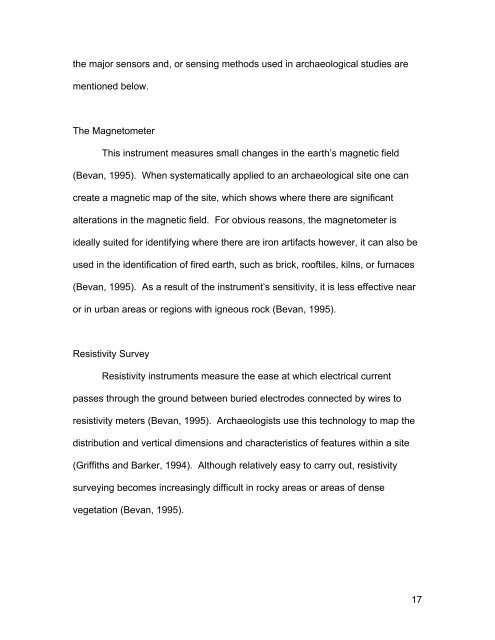A Review of Remote Sensing Application in Archaeological Research
A Review of Remote Sensing Application in Archaeological Research
A Review of Remote Sensing Application in Archaeological Research
You also want an ePaper? Increase the reach of your titles
YUMPU automatically turns print PDFs into web optimized ePapers that Google loves.
the major sensors and, or sens<strong>in</strong>g methods used <strong>in</strong> archaeological studies are<br />
mentioned below.<br />
The Magnetometer<br />
This <strong>in</strong>strument measures small changes <strong>in</strong> the earth’s magnetic field<br />
(Bevan, 1995). When systematically applied to an archaeological site one can<br />
create a magnetic map <strong>of</strong> the site, which shows where there are significant<br />
alterations <strong>in</strong> the magnetic field. For obvious reasons, the magnetometer is<br />
ideally suited for identify<strong>in</strong>g where there are iron artifacts however, it can also be<br />
used <strong>in</strong> the identification <strong>of</strong> fired earth, such as brick, ro<strong>of</strong>tiles, kilns, or furnaces<br />
(Bevan, 1995). As a result <strong>of</strong> the <strong>in</strong>strument’s sensitivity, it is less effective near<br />
or <strong>in</strong> urban areas or regions with igneous rock (Bevan, 1995).<br />
Resistivity Survey<br />
Resistivity <strong>in</strong>struments measure the ease at which electrical current<br />
passes through the ground between buried electrodes connected by wires to<br />
resistivity meters (Bevan, 1995). Archaeologists use this technology to map the<br />
distribution and vertical dimensions and characteristics <strong>of</strong> features with<strong>in</strong> a site<br />
(Griffiths and Barker, 1994). Although relatively easy to carry out, resistivity<br />
survey<strong>in</strong>g becomes <strong>in</strong>creas<strong>in</strong>gly difficult <strong>in</strong> rocky areas or areas <strong>of</strong> dense<br />
vegetation (Bevan, 1995).<br />
17
















